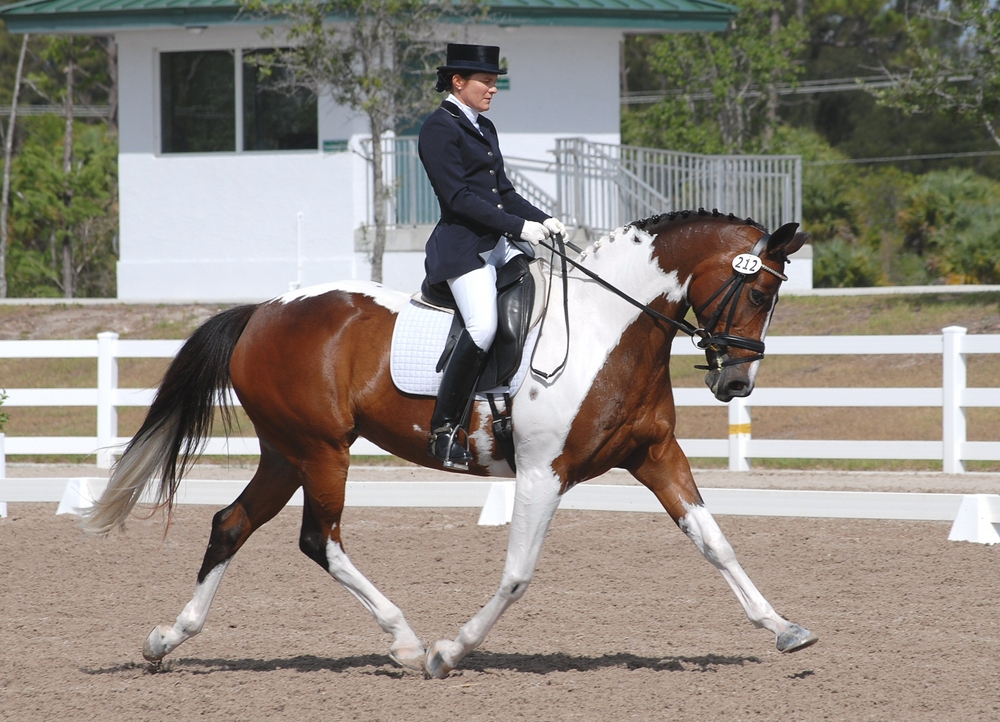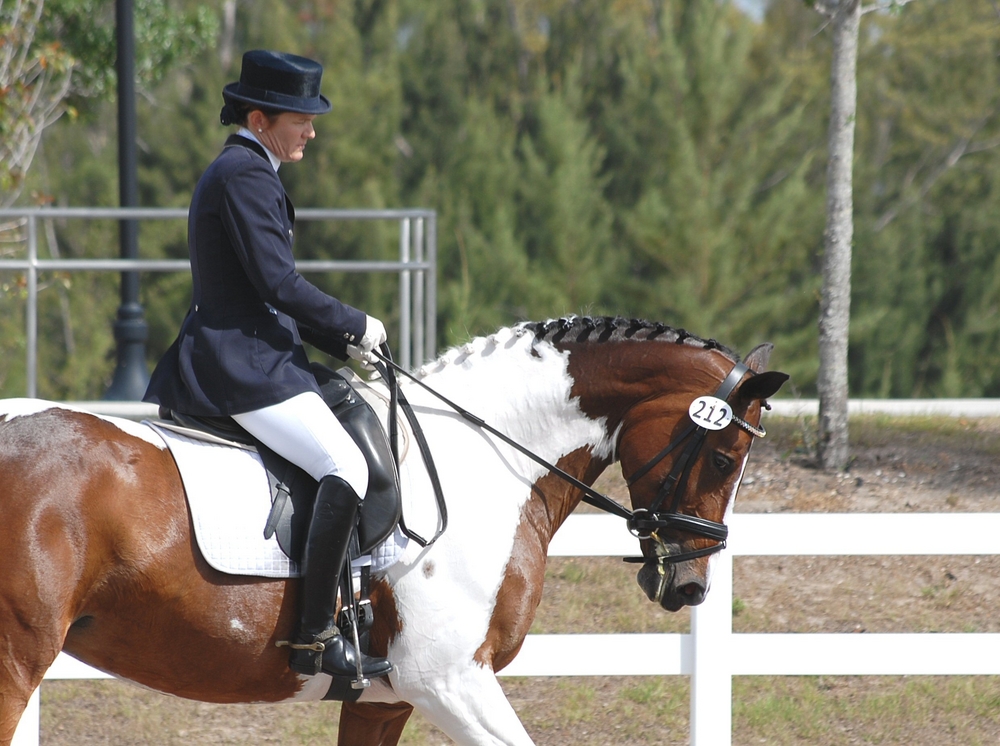
The American Paint horse was initially bred as a colorful, wonderfully robust stock horse. These horses are exceptional at ranch work, but can they transform themselves into dancing ballerinas and take the dressage world by storm?
A Paint horse can do dressage, especially western dressage. Dressage is designed to help horses move in lightness and balance while being responsive and attuned to their rider’s aids. Paint horses rarely have the natural aptitude required to perform well at high-level English dressage.
A moderately talented horse with a good rider would reach Grand Prix at approximately 10 – 14yrs of age. Choosing a horse who can support you in your dressage dreams is paramount to determining your success. Is the cheerful Paint horse an asset or burden for aspiring dressage riders?
How Does The Paint Horses’ Conformation Affect Dressage Ability?
Paint horses and dressage horses show wildly different conformations.
Dressage Horse Conformation
A dressage horse is always built uphill with a high neck-wither connection. The neck is long and graceful, gradually tapering into an elegant throatlatch.
Dressage horses have powerful hindquarters, placed well under their center of mass, laid back shoulders, and a relatively long leg-to-height ratio.
Paint Horse Conformation
By contrast, many Paint horses have a more downhill conformation with a low-set neck. The neck is powerfully built with moderate length, and the throatlatch is of medium thickness.
Like the dressage horse, the Paint horse has powerful hindquarters, but these are not placed as far under the horse as seen in dressage horses. They have a shorter leg-to-height ratio than dressage horses.
The Biomechanical Purpose Of Dressage
Dressage aims to teach the horse how to improve its way of going through a logical training program designed to enhance its flexibility, balance, and strength.
The pinnacle of dressage training is achieved when the horse can shift its weight onto its hind legs and lift the shoulders, wither and neck through the engagement of the abdominal and spinal muscles. An advanced dressage horse should carry most or even all of its weight on its hind legs according to the specific movements required.
The Effects Of Paint Horse Conformation And Dressage
Imagine a straight line going from your horse’s mouth, through their body, and out through the middle of the hindquarter. Now picture the line as a rigid lever that can pivot about the center of the horse’s body.
Keeping that picture firmly in your mind’s eye, imagine the horse starting to sit down. As the hindquarters are lowered, it will cause the front end of the horse to be lifted. Now picture the opposite happening; the horse bucks and lifts its hindquarters. What happens? The head and neck go down.
You may be unfamiliar with two terms I used previously: “uphill conformation” and “downhill conformation.” These conformation types are so-called because of the height of their wither relative to the height of the highest point of the horse’s hip.
Dressage horses are built uphill, and thus even when standing still, the back of the lever is tilted downwards, and the withers, neck, and head are elevated above the horizontal line.
Before the rider has even got on, the horse’s natural conformation would have done half the work related to hindquarter engagement. The horse will naturally shift its weight backward and show incredible front leg expression.
By contrast, Paint horses with a strong quarter horse influence are built more downhill. The lever is tilted down at the front, and both the horse and rider will have to work significantly harder to shift the horse’s weight towards the hind legs. This desired weight shift is further compromised by the Paint horse’s low-set heavy neck.
Do Paint Horses Benefit From Dressage Training?
Dressage is derived from the French word “training”; contrary to what most people think, dressage is for the benefit of the horse, not the other way around.
Dressage focuses on sympathetically gymnatizing your horse through a systematic approach that focuses on developing your horses:
- Obedience
- Lightness and reactivity to aids
- Balance
- Strength
- Control and coordination
- Power
Thus, even though the Paint horse is not built for dressage, dressage can still provide immeasurable benefits to Paint horses. It’s a little like Pilates for humans. Not all humans are destined to be gymnasts, but all humans could benefit from practicing Pilates.
Are Paint Horses Successful In Dressage?
Many owners prefer to avoid competition and practice alternative dressage (i.e., Straightness Training, Ecole de Légèreté, Liberty dressage, etc.) with their Paint Horses. Many of these Paint horses learn how to perform most of the Grand Prix movement, although do not execute the movements with the finesse of a competition horse.
Typically Paint horses do well in low-level or even midlevel dressage competitions. Despite this, these three Paint horses showed exceptional dressage results in 2012:
- Flashback to Robin successfully competed at fourth level.
- Rhapped For Pleasure was competing at third level with points for fourth level.
- Miss Handy was the most advanced of the dressage-winning Paint horses and had just made her Grand Prix debut.
Interestingly, all three Paint horses had a high percentage of thoroughbred blood.
No American Paint horse has successfully competed in FEI open tour Grand Prix dressage competitions.

Are Paint Horses Better Suited To Western Dressage?
Western dressage was developed by a western rider riding western horse breeds. Thus Western dressage does not penalize the horse for moving in accordance with the breed’s natural way of moving.
Furthermore, trotting is replaced with jogging and cantering with loping. 360° turns on both the forehand and hindquarters have been built into western dressage tests.
These movements are much easier for a Paint horse to perform, and thus the breed will score better in Western dressage than English dressage.
Should I Sell My Paint Horse For A Dressage Horse?
Dressage-bred horses are tall, highly sensitive, sharp, and often spooky ultra-athletes. The stud barns are not overly concerned with creating a robust, sensible or easy horse but rather a horse that shows elegance, power, and charisma.
In short, these horses are incredibly talented athletes that are occasionally terrifying to handle!
Novice riders, nervous riders, and pleasure riders should stick with their safe, sure-footed, sensible Paint horses. These horses may not win the big prizes, but they will keep you safe as you learn and, more importantly, allow you to enjoy your rides.
Committed riders with dressage aspirations will need to switch to riding dressage-bred horses. But be warned, the learning curve is usually vertical and requires an experienced trainer to help you navigate the riding and management of a dressage horse.
Conclusion
The Paint horse, like any breed of horse, can do dressage. Although the Paint horses’ conformation is not ideally suited towards high-level dressage, Paint horses can still be successful at low to mid-level competitive English dressage.
Western dressage is better suited to most Paint Horses’ conformational strengths and weaknesses.
Regardless of the Paint horses’ competitive success, both horse and rider will benefit from practicing classically correct dressage. Even pure western riders will see an improvement in their horse’s ridden performance if schooled according to fundamental dressage principles.
